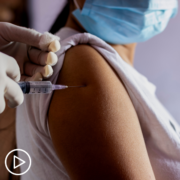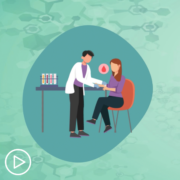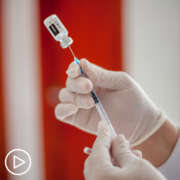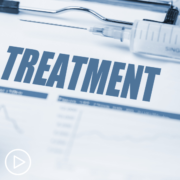Is My DLBCL Treatment Working? What Happens If It Doesn’t Work?
Is My DLBCL Treatment Working? What Happens If It Doesn’t Work? from Patient Empowerment Network on Vimeo.
Diffuse large B-cell lymphoma (DLBCL) expert Dr. Kami Maddocks describes how a treatment’s effectiveness is evaluated and reviews the options available for refractory patients.
Dr. Kami Maddocks is a hematologist who specializes in treating patients with B-cell malignancies at the The Ohio State University Comprehensive Cancer Center – The James. Learn more about Dr. Maddocks.
See More From The Pro-Active DLBCL Patient Toolkit
Related Programs:

|

|
Transcript:
Katherine:
So, how do you know if a treatment is working?
Dr. Maddocks:
So, as far as evaluating treatment, you get a scan before you start treatments, so we know where all the lymphoma is at. And then, typically, you get some sort of scan in the middle of treatment, and then after, you complete your six cycles of treatment. Or for early stages, sometimes patients will get less than six cycles. So, we get scans to make sure it’s working. So, you can tell by those things, how much has gone, hopefully all of it has gone by the end. Occasionally, patients that had a lot of symptoms to start with, their symptoms will go away, and then they’ll start coming back.
This is less common, because the majority of patients do respond to chemotherapy. It’s less common to get patients who are what is called refractory, meaning they don’t get any response to therapy. So, occasionally they’ll note symptoms but a lot of times, we’ll see something on that mid-therapy or end of therapy scan, if it’s not going to make it all go away.
Katherine:
So, if a treatment doesn’t work, what happens then?
Dr. Maddocks:
If treatment doesn’t work, it depends a little bit – and now it depends a little bit on the timing of that treatment not working. So, it used to be that patients who were eligible for treatment, no matter if it didn’t work right away or if it put them into what we call a remission, so there’s no evidence of disease and then it relapsed, they would have the option of further chemotherapy and then an autologous stem cell transplant. So, a bone marrow transplant where they donate their own cells.
If they were in a good enough health or if they were not – to do that, you have to donate your own bone marrow cells and as we age, we make less bone marrow cells. So, once you reach a certain age, your body can’t produce enough cells to donate to a transplant. In those patients, we offer them less aggressive chemo options, which were not known to be curable but could put them into remission again, for a while. More recently, there has been some that chimeric antigen receptor T-cell therapy that I mentioned where you actually donate your own T cells. So that’s –. And your lymphoma is of your B cells.
Your T cells are in another immune cell that should recognize that lymphoma is bad and attack it, and they’re not functioning properly. So, you donate your own T cells, and they’re sent off and reengineered to target a protein on the tumor. Then, you get those cells back, and they’re meant to target the lymphoma and kill the lymphoma cells.
So, that is now an approved therapy for patients who don’t achieve the remission – so, who’s first chemo doesn’t work or if they relapse within a year of completing chemo. So, that’s a possibility. The chemo and transplants a possibility. Or there’s other approved therapies now, that can be given as second options or third or later options, which have been shown to keep patients in remission for a while.
Katherine:
Dr. Maddocks, you touched up on this a moment ago, but what are the approaches if a patient relapses? What do you do?
Dr. Maddocks:
So, you would rework them up if they relapsed. Similar to that, if they relapse within a year and they have access to the CAR-T and they’re healthy for that, then that’ll be an option. The second type of chemotherapy in the transplant. So, you can’t just go straight to a transplant. You have to get a different type of chemotherapy to try to get the disease under control again, before you would go to a transplant.
Or there’s a number of other targeted therapies that are approved. So, there’s other – I talked about rituximab (Rituxan) is given in the first line, that targets a CD-20 protein, there’s an antibody that targets a CD-19 protein that’s given out in relapse. There’s another antibody drug – there’s actually two antibody drug conjugates. So, an antibody that targets the protein on the cells that are attached to a chemo, that’s given. Or there’s different chemotherapy and then even some oral therapies.
Katherine:
Okay. So, there’s a lot of different options available for people.
Dr. Maddocks:
Correct. And there’s always clinical trials. So, there’s always the option to find something where we’re studying some of these newer therapies. They’re therapies in combination.











